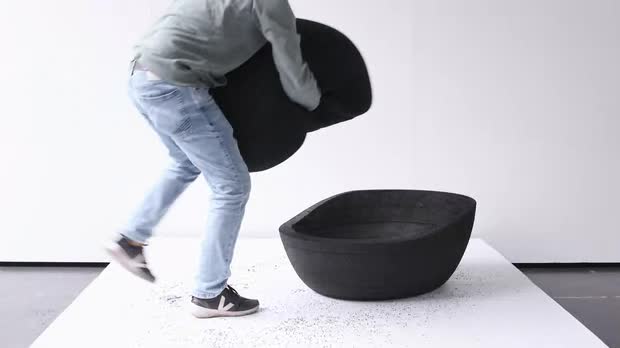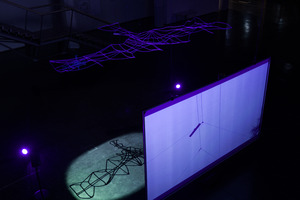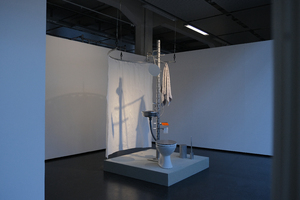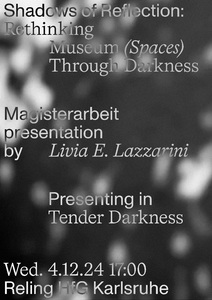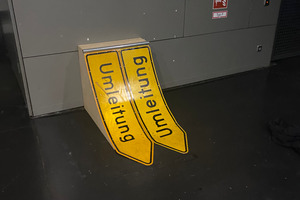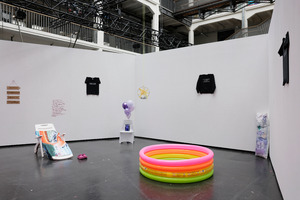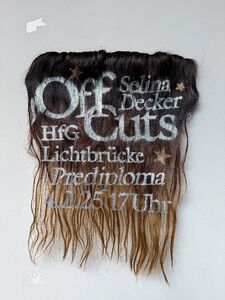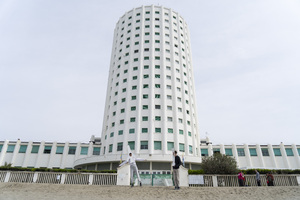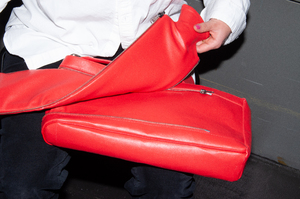Testzentrum für chronischen Automobilismus
Benachbarte Sets (123)Alle Zusammenhänge anzeigen
Diese Sets wurden den gleichen Sets hinzugefügt wie das ausgewählte Set.
123 Inhalte
- Seite 1 von 11
Float
- Titel
- Float
- Titel (en)
- Float
- Autor/in
- Beschreibung (de)
- Der Float Lounger, entworfen von Felix Reif und Finn de Bruyn, hebt den Sitzsack auf das Niveau eines vollwertigen Relaxmöbels.
Sowohl die Basis als auch das Kissen bestehen aus expandiertem Polypropylen. Der Einsatz dieses innovativen Materials, das in der Möbelproduktion nur selten verwendet wird, ermöglicht einen leichten, robusten und zu 100 % recycelbaren Sitz. Das mit expandierten Polypropylen-Perlen gefüllte Kissen passt sich jeder Körperform an, steigert die Entspannung und vermittelt dabei das Gefühl, an einem Sonntagabend in einem Schaumbad zu versinken.
- Der Float Lounger, entworfen von Felix Reif und Finn de Bruyn, hebt den Sitzsack auf das Niveau eines vollwertigen Relaxmöbels.
- Beschreibung (en)
- The Float lounger, designed by Felix Reif and Finn de Bruyn, elevates the bean bag to the level of a full-fledged piece of relaxation furniture.
The base and cushion are made of expanded polypropylene. The use of this innovative material, which is rarely found in furniture production, allows for a lightweight, resilient, and 100% recyclable seat. The cushion, filled with expanded polypropylene beads, adapts to every body shape enhancing relaxation while creating the sensation of sinking into a bubble bath on a Sunday evening.
- The Float lounger, designed by Felix Reif and Finn de Bruyn, elevates the bean bag to the level of a full-fledged piece of relaxation furniture.
- Kategorie
- Typ des Projekts/Werks
- Datierung
- 02.2025
- Mitwirkende
- Dank an
- Material
- Titel
- Float
- Importiert am
- 21.07.2025
- Übergeordnete Sets
- 1
- Set enthält
- 0 7
„Meine Zuständigkeit hört auf, da wo der Strom kommt“
- Titel
- „Meine Zuständigkeit hört auf, da wo der Strom kommt“
- Autor/in
- Beschreibung (de)
- „Meine Zuständigkeit hört auf, da wo der Strom kommt“ ist eine Installation über Straßenbahnoberleitungen. Sie setzt sich mit Infrastrukturen im öffentlichen Raum auseinander, die für uns im Alltag essenziell sind, die wir aber gelernt haben auszublenden. Sie soll diesen scheinbar banalen, anonymen Zweckbauten einen Wert verleihen und auf sie aufmerksam machen.
Oberleitungen sind in einer Stadt mit vielen Straßenbahnen, wie Karlsruhe, wenn man sich auf der Straße bewegt, immer da. Alles, was man im öffentlichen Raum sieht, sieht man durch das Netz der Oberleitungen. Sie sind allgegenwärtig und ein wichtiger Bestandteil der täglichen Fortbewegung, doch die meisten Leute blenden das im alltäglichen Leben aus. Und das ist kein Zufall: die Stadt schreibt vor, Oberleitungen so zu planen, dass sie möglichst unauffällig sind und in ihrer Umgebung untergehen. Es gibt keine Wertschätzung dafür, wie viel Technik und Material dahinter steckt, dass man sich mit der Straßenbahn durch die Stadt bewegen kann.
Auf diese Themen soll die Installation aufmerksam machen. Ich habe durch diese Arbeit einen intensiven Blick auf Oberleitungen bekommen und wollte diesen durch meine Installation teilen.
In der Installation „Meine Zuständigkeit hört auf, da wo der Strom kommt“ steht man, unter dem im Maßstab 1:26, aus blauen Seilen nachgebildeten, freischwebenden Muster, einer großen Kreuzung in Karlsruhe. Auf der Leinwand läuft ein Stop Motion Video, das alltägliche Momentaufnahmen und Blicke in Bewegung auf die Oberleitungen zeigt.
Aus drei verschiedenen Richtungen kommen Sounds. Einmal die Klänge der Bahnen, denen man auch auf einer Kreuzung zuhören könnte, und dann von rechts und links, zwei verschiedene Blickwinkel, von verschiedenen Personen auf das Thema Oberleitungen. Eins ist der technische Blick von einer Person, die mit Oberleitungen arbeitet, und der andere ist meiner, ein eher poetischer Blick den ich auf die bildliche Ebene der Oberleitungen gewonnen habe. Die eine Seite sagt, dass die Oberleitungen möglichst unauffällig sein sollen, um nicht aufzufallen, und die andere sagt, schaut nach oben, schaut was da alles hängt.
Die Installation soll den Blick der Leute, die sie anschauen, in Zukunft etwas öfter nach oben auf die Oberleitungen lenken
- „Meine Zuständigkeit hört auf, da wo der Strom kommt“ ist eine Installation über Straßenbahnoberleitungen. Sie setzt sich mit Infrastrukturen im öffentlichen Raum auseinander, die für uns im Alltag essenziell sind, die wir aber gelernt haben auszublenden. Sie soll diesen scheinbar banalen, anonymen Zweckbauten einen Wert verleihen und auf sie aufmerksam machen.
- Beschreibung (en)
- “Meine Zuständigkeit hört auf, da wo der Strom kommt” is an installation about tram overhead lines. It explores infrastructures in public spaces that are essential to our everyday lives but which we have learnt to ignore. It is intended to give these seemingly banal, anonymous functional structures a value and draw attention to them.
In a city with a lot of trams, like Karlsruhe, overhead lines are always present when you move along the street. Everything you see in public space is seen through the web of overhead lines. They are omnipresent and essential to everyday transport, however most people ignore them in their day to day lives. And this is no coincidence: the city requires overhead lines to be planned in such a way that they are as discreet as possible and blend into their surroundings. There is no appreciation of how much technology and material goes into getting a tram through the city.
The installation is intended to draw attention to this topic. This work and research has allowed me an immersive view of overhead lines, which I wanted to share and visualise through my installation.
In the installation “Meine Zuständigkeit hört auf, da wo der Strom kommt”, one stands and moves under the free-floating pattern of a large intersection in Karlsruhe, modelled on a scale of 1:26 using blue ropes. A stop motion video runs on the projection screen, showing everyday snapshots and views of the overhead lines in motion.
Sounds come from three different directions. Firstly, the sounds of the trains, which you could also listen to at a crossing, and then from the right and left, two different perspectives, from different people on the subject of overhead lines. One is the technical view of a person who works with overhead lines, and the other is mine, a more poetic view that I have gained of the visual level of the overhead lines. One side says that the overhead lines should be as subtle as possible in order not to attract attention, and the other says, look up, see what's hanging there.
With my installation I hope to draw people’s attention to the overhead lines that play such an important yet invisible role in our daily lives.
- “Meine Zuständigkeit hört auf, da wo der Strom kommt” is an installation about tram overhead lines. It explores infrastructures in public spaces that are essential to our everyday lives but which we have learnt to ignore. It is intended to give these seemingly banal, anonymous functional structures a value and draw attention to them.
- Kategorie
- Typ des Projekts/Werks
- Datierung
- 24.04.2025
- Ort
- Lichthof drei
- Titel
- „Meine Zuständigkeit hört auf, da wo der Strom kommt“
- Projektleiter/in
- Semester
- Studiengang
- Typ der Abschlussarbeit
- Importiert am
- 15.07.2025
- Übergeordnete Sets
- 1
- Set enthält
- 0 7
ChitoTinkering
- Titel
- ChitoTinkering
- Titel (en)
- ChitoTinkering
- Untertitel
- neue perspektiven für chitosan
- Untertitel des Projekts/Werks (en)
- new perspectives for chitosan
- Autor/in
- Beschreibung (de)
- Im Rahmen ihres Materialforschungsprojekts entwickelten Benjamin Kaltenbach, Lilith Stumpf, Felix Harr und Julia Ihls innovative Anwendungen für Chitosan – ein vielseitiges Biopolymer, das aus Chitin gewonnen wird. Chitin ist nach Cellulose das zweithäufigste natürliche Polymer und bildet die strukturelle Basis für die Schalen von Krebstieren, die Exoskelette von Insekten sowie Zellwände bestimmter Pilze.
Inspiriert von der schützenden Funktion von Chitin in der Natur übertrugen die Designer*innen die Materialeigenschaften von Chitosan in einen alltagsnahen Kontext. Der Fokus lag dabei auf den Konzepten von Gehäusen und Hüllen – Anwendungen, die Schutz und Struktur vereinen. Das Ergebnis sind eine Reihe funktionaler Prototypen, darunter ein Lampenschirm, ein Stift, transparente Dokumentenhüllen sowie eine Dokumentenmappe, die aus dem Chitosan-Komposit gefertigt wurden.
Um die gestalterischen und technischen Möglichkeiten des Materials auszuloten, wurden unterschiedliche Bearbeitungstechniken erprobt: Das Chitosan-Material wurde genäht, genietet, gebügelt, gefaltet, selbstverklebt sowie mittels CNC-Laser graviert und geschnitten. Diese experimentelle Auseinandersetzung mit Verarbeitungstechniken hebt die gestalterische Vielseitigkeit von Chitosan hervor und zeigt sein Potenzial als nachhaltige Material Alternative auf.
Durch diese gestalterische und technische sowie konzeptuelle Auseinandersetzung eröffnen die Designer*innen neue Perspektiven für Chitosan und unterstreichen sein Potenzial als nachhaltige Material Alternative.
- Im Rahmen ihres Materialforschungsprojekts entwickelten Benjamin Kaltenbach, Lilith Stumpf, Felix Harr und Julia Ihls innovative Anwendungen für Chitosan – ein vielseitiges Biopolymer, das aus Chitin gewonnen wird. Chitin ist nach Cellulose das zweithäufigste natürliche Polymer und bildet die strukturelle Basis für die Schalen von Krebstieren, die Exoskelette von Insekten sowie Zellwände bestimmter Pilze.
- Beschreibung (en)
- As part of their material research project, Benjamin Kaltenbach, Lilith Stumpf, Felix Harr, and Julia Ihls developed innovative applications for chitosan – a versatile biopolymer derived from chitin. Chitin is the second most abundant natural polymer after cellulose and forms the structural basis of crustacean shells, insect exoskeletons, and the cell walls of certain fungi.
Inspired by chitin’s protective function in nature, the designers translated the material properties of chitosan into everyday applications. Their focus was on the concept of enclosures and casings – objects that combine protection and structure. The result is a series of functional prototypes, including a lampshade, a pen, transparent document sleeves, and a folder, all made from chitosan composite material.
To explore the material’s creative and technical potential, various processing techniques were tested: The chitosan material was sewn, riveted, ironed, folded, self-adhered, and engraved or cut using a CNC laser. This experimental approach highlights the versatility of chitosan and demonstrates its potential as a sustainable material alternative.
Through this design and technical exploration, the designers open up new perspectives for chitosan and emphasize its potential as an innovative, bio-based material.
- As part of their material research project, Benjamin Kaltenbach, Lilith Stumpf, Felix Harr, and Julia Ihls developed innovative applications for chitosan – a versatile biopolymer derived from chitin. Chitin is the second most abundant natural polymer after cellulose and forms the structural basis of crustacean shells, insect exoskeletons, and the cell walls of certain fungi.
- Kategorie
- Typ des Projekts/Werks
- Schlagworte
- Datierung
- Februar 2025
- Mitwirkende
- Dank an
- Material
- Ort: Institution
- Ort
- Unter dem Bio Design Lab
- Stadt
- Land
- Internetlinks
- Titel
- ChitoTinkering
- Importiert am
- 17.07.2025
- Übergeordnete Sets
- 1
- Set enthält
- 0 9
Aqua Logistik
- Titel
- Aqua Logistik
- Titel (en)
- Aqua logistics
- Autor/in
- Beschreibung (de)
- Aqua Logistik ist ein Konzept für ein alternatives Badezimmer. Im Mittelpunkt des Entwurfs steht eine Säule, die gleichzeitig als Wasserverteilungssystem dient. Durch das Einsetzen von Komponenten in die perforierte Säule können die Nutzer das Bad nach ihren Bedürfnissen gestalten. Durch die Vereinfachung und Minimierung des Wassermanagements fördert das System einen direkteren Umgang mit der wertvollen Ressource Wasser.
Der modulare Aufbau ermutigt zu unterschiedlichen Reinigungsroutinen und lädt dazu ein, die Gewohnheiten im Bad zu überdenken - und fördert so einen intelligenteren Umgang mit Wasser im privaten Bereich. Die Grundlage für dieses Konzept bildet eine selbst durchgeführte Untersuchung und Umfrage, die in einer Publikation mit dem Titel veröffentlicht wurde: „May I ask you some Questions about your Bathroom usage“.
- Aqua Logistik ist ein Konzept für ein alternatives Badezimmer. Im Mittelpunkt des Entwurfs steht eine Säule, die gleichzeitig als Wasserverteilungssystem dient. Durch das Einsetzen von Komponenten in die perforierte Säule können die Nutzer das Bad nach ihren Bedürfnissen gestalten. Durch die Vereinfachung und Minimierung des Wassermanagements fördert das System einen direkteren Umgang mit der wertvollen Ressource Wasser.
- Beschreibung (en)
- Aqua Logistics is a concept for an alternative bathroom. The design centers around a column that also serves as the water distribution system. By inserting components into the perforated column, users can customize the bathroom according to their needs. By simplifying and minimizing water management, the system fosters a more direct relationship with the valuable resource of water.
The modular setup encourages diverse cleaning routines and invites a rethinking of bathroom habits—ultimately promoting more intelligent water usage in private spaces. The base for this concepts relies on a self conducted research and survey, published in a book called: “May I ask you some Questions about your Bathroom usage“.
- Aqua Logistics is a concept for an alternative bathroom. The design centers around a column that also serves as the water distribution system. By inserting components into the perforated column, users can customize the bathroom according to their needs. By simplifying and minimizing water management, the system fosters a more direct relationship with the valuable resource of water.
- Kategorie
- Typ des Projekts/Werks
- Schlagworte
- Datierung
- 30.04.2025
- Mitwirkende
- Dank an
- Johannes Bauer
- Patricia Capalija
- Athina Chrisofakis
- Lukas Clark
- Lukas Dechau
- Fabian Düss
- Rustam Faradzev
- Hannes Holstein
- Chris Kabel
- Tobias Keilbach
- Alexander Knoppik
- Mikail Kolbasar
- Julian Kuf
- Stefan Legner
- Anouk Merceron
- Tim Miler
- Lea Möscheid
- Francesco Perale
- Jana Renger
- Sebastian Schäfer
- Sebastian Schilbach
- Susanne Schmitt
- Marlon Schüch
- Wieki Somers
- Yannik Thamm
- Thomas Traxler
- Leonard Wille
- Levi Zimmermann
- Material
- Abmessungen
- Breite: 150cm, Länge: 150cm, Höhe 220 cm
- Ort: Institution
- Ort
- Lichtbrücke
- Stadt
- Land
- Titel
- Aqua Logistik
- Projektleiter/in
- Semester
- Studiengang
- Typ der Abschlussarbeit
- Importiert am
- 16.06.2025
- Übergeordnete Sets
- 1
- Set enthält
- 0 16
Shadows of Reflection
- Titel
- Shadows of Reflection
- Untertitel
- Rethinking Museum (Spaces) Through Darkness
- Autor/in
- Beschreibung (de)
- In zeitgenössischen Museen können hell erleuchtete Räume - die so genannten „White Boxes“ - im Zusammenspiel mit Kunstwerken, die Szenen von Gewalt und Diskriminierung darstellen, befremdlich wirken. Auch wenn es wichtig ist, historische Ereignisse aufzuarbeiten und Minderheitengruppen sichtbar zu machen, kann der Kontrast zwischen der hellen Umgebung, dem behandelten Sachverhalt und der Realität selbst in diesen Kontexten zu einer Entfremdung führen.
Diese Magisterarbeit untersucht das Spannungsverhältnis zwischen hell erleuchteten Museumsräumen und der Darstellung schwieriger politischer Themen und schlägt dunkle Umgebungen als Gegennarrative vor. Keller, Bunker und Dunkelkammern können in diesem Sinne Erlösungsräume sein, die Platz für die Neudefinition von Machtstrukturen, für Freiheit und Emotionen lassen. Ein dunkler Raum ermöglicht somit transformative Erfahrungen, bei denen der Blick negiert und das Gefühl von Verletzlichkeit spürbar wird , was zu Überlegungen darüber einlädt, wie eine eingeschränkte Sichtbarkeit paradoxerweise unsere Fähigkeit, in einem umfassenderen, emotionaleren und bewussteren Sinne zu „sehen“, verstärken könnte. Dies wirft folgende Frage auf: Kann Dunkelheit emotionale Nähe fördern und neue Sichtweisen unterstützen?
- In zeitgenössischen Museen können hell erleuchtete Räume - die so genannten „White Boxes“ - im Zusammenspiel mit Kunstwerken, die Szenen von Gewalt und Diskriminierung darstellen, befremdlich wirken. Auch wenn es wichtig ist, historische Ereignisse aufzuarbeiten und Minderheitengruppen sichtbar zu machen, kann der Kontrast zwischen der hellen Umgebung, dem behandelten Sachverhalt und der Realität selbst in diesen Kontexten zu einer Entfremdung führen.
- Beschreibung (en)
- In contemporary museum spaces, the prevalence of brightly lit spaces – the so-called “white-boxes” – can be jarring when juxtaposed with artworks representing scenes of violence and discrimination. While it is essential to process historical events and give visibility to minority groups, in these contexts, the contrast between the bright environment, the subject matter and reality itself can create a disconnect.
This dissertation explores the tension between brightly lit museum spaces and their representation of challenging political subjects, proposing dark environments as a counter-narrative. Basements, bunkers and darkrooms, in this sense, can be redemption spaces that leave room for redefining power structures, for freedom and emotions. A dark space is thus a fundamental way of facilitating transformative experiences, where the gaze is negated and we all feel vulnerable, inviting considerations of how limited visibility might paradoxically enhance our ability to "see" in a broader, more emotionally and intentional engaged sense – raising the question: can darkness foster emotional proximity and encourage new ways of seeing?
- In contemporary museum spaces, the prevalence of brightly lit spaces – the so-called “white-boxes” – can be jarring when juxtaposed with artworks representing scenes of violence and discrimination. While it is essential to process historical events and give visibility to minority groups, in these contexts, the contrast between the bright environment, the subject matter and reality itself can create a disconnect.
- Kategorie
- Schlagworte
- Datierung
- 26.12.2024
- Sprache
- Titel
- Shadows of Reflection
- Projektleiter/in
- Semester
- Studiengang
- Typ der Abschlussarbeit
- Externes Archiv
- Importiert am
- 16.06.2025
- Übergeordnete Sets
- 0
- Set enthält
- 0 5
rethinking public space
- Titel
- rethinking public space
- Titel (en)
- rethinking public space
- Autor/in
- Beschreibung (de)
- „rethinking public space“ ist ein Projekt, das sich mit Street-Skating und Skate-Kultur befasst und untersucht, wie Skateboarder öffentliche Räume neudenken und umgestalten können.
Das Projekt besteht aus einer Publikation mit Fotos von Street-Skate-Spots und Interviews. Es enthält ein Interview mit der Stadt Stuttgart, über den Bau von Skateparks, DIY-Parks und Skate-Stoppern, und ein zweites Interview mit einem Skateboarder und Content Creator aus San Diego, der über die Skate-Kultur, ihre Beziehung zur Öffentlichkeit und die kreativen Wege spricht, mit denen Skateboarder Herausforderungen überwinden.
Die Publikation funktioniert wie ein Daumenkino, das alle Skate-Spots aus dem gleichen Blickwinkel zeigt und die Bewegung des Grindens durch sie hindurch nachahmt, unterbrochen nur durch Skate-Stopper-Seiten. Darauf folgen die Interviews.
Die Publikation ist in ein mit Wachs versiegeltes, siebgedrucktes Stoffband mit dem Namen der Publikation eingewickelt.
Weitere Wachsbänder, die jeweils einen Auszug aus einem der Interviews zeigen, sind über die gesamte Ausstellung verteilt.
Ein weiteres Element des Projekts auf Wachsbasis sind die Skatestopper-Wachsrepliken, die den Skatestoppern in Karlsruhe nachempfunden sind und das Skateboarden ermöglichen, anstatt es zu verhindern.
Begleitend zur Publikation gibt es eine Rampe aus alten Straßenschildern und Holzabfällen sowie eine Rail aus einem alten Rutschen-Seitenteil. Diese Elemente sind eine Hommage an DIY-Skate-Spots und nutzen kostengünstige, leicht verfügbare Ressourcen.
- „rethinking public space“ ist ein Projekt, das sich mit Street-Skating und Skate-Kultur befasst und untersucht, wie Skateboarder öffentliche Räume neudenken und umgestalten können.
- Beschreibung (en)
- 'rethinking public space' is a project focusing on street skating and skate culture, as well as exploring how skateboarders can reuse and reshape public spaces.
The project consists of a publication containing photographs of street skate spots and interviews. There is one interview with a city official talking about the process of building skate parks, DIY parks and skate stoppers, and a second interview with a skateboarder and content creator from San Diego talking about skate culture, its relationship with the public, and the creative ways skateboarders overcome obstacles.
The publication functions as a flipbook, showing all the skate spots from the same angle and emulating the motion of grinding through them, interrupted only by skate stopper pages. These are followed by the interviews.
The publication is wrapped in a wax-sealed, screen-printed cloth band bearing the publication's name.
More wax bands, each showcasing an excerpt from one of the interviews, are spread throughout the exhibition.
Another wax-based element of the project is the skatestopper wax replicas, modelled on those found in Karlsruhe, which enable skateboarding rather than prevent it.
Accompanying the publication is a ramp made from scrap street signs and discarded wood, as well as a rail made from an old slide side piece. These elements pay homage to DIY skate spots and utilise affordable, readily available resources.
- 'rethinking public space' is a project focusing on street skating and skate culture, as well as exploring how skateboarders can reuse and reshape public spaces.
- Kategorie
- Typ des Projekts/Werks
- Schlagworte
- Datierung
- 02.07.2025
- Dank an
- Sprache
- Material
- Technik/Verfahren/Formate
- Siebdruck, Lumbecken, Folienplott,
- Abmessungen
- Breite: 195mm, Höhe: 140mm
- Ort: Institution
- Ort
- Unter der Lichtbrücke
- Stadt
- Land
- Titel
- rethinking public space
- Projektleiter/in
- Semester
- Studiengang
- Typ der Abschlussarbeit
- Importiert am
- 21.07.2025
- Übergeordnete Sets
- 1
- Set enthält
- 3 0
In Defense of Mis Caprichos
- Titel
- In Defense of Mis Caprichos
- Untertitel
- – When someone says you canʼt do something. Do it twice, and take pictures.
- Autor/in
- Beschreibung (de)
- „In Defense of Mis Caprichos“ ist eine multimediale Ausstellung, die auf einem selbst kuratierten Archiv von 140 gefundenen und eigenen Bildern basiert. Sie setzt sich mit der vernakulären Bildsprache Lateinamerikas auseinander – von Memes und persönlichen Fotos bis zu Screenshots. Viele Bilder sind durch digitale Verbreitung nur in niedriger Auflösung erhalten und spiegeln so die visuelle Textur des Internets wider. Sie vermitteln eine Sensibilität, die sich nicht erklären lässt, sondern sich durch Stimmung, Ton und Wiederholung entfaltet. Viele der Bilder stammen aus oder zeigen Kontexte des Globalen Südens und verstehen sich als Hommage an dortige alltägliche, informelle Gesten. Zusammen bilden sie eine visuelle Sprache, die intim, vielschichtig, instabil und oft humorvoll ist.
Das Projekt bezieht sich auf Hal Fosters Aufsatz „An Archival Impulse“, der das Archivieren als künstlerische Praxis versteht und Fragmentierung der Kohärenz vorzieht – zentrale Konzepte für dieses sich stetig wandelnde Archiv. Daraus wurden zehn künstlerische Objekte entwickelt, die die Skurrilitäten der Sammlung erfassen: Repliken, Performances oder hybride Assemblagen. Ihre Logik beruht auf Aneignung, Kopie und Transformation – im Sinne Byung-Chul Hans, der Replikation als kreative Strategie für neue Bedeutungen begreift.
Einige Werke greifen konkrete Bilder auf: Eine Performance, bei der ein Plastikpool auf einem Motorrad transportiert wird, bezieht sich auf ein Archivbild. Ein anderes verwandelt einen falsch übersetzten Tweet in ein dekoratives Holzschild. Ein drittes ist ein Traumfänger aus gelber Unterwäsche – inspiriert von einem kolumbianischen Neujahrsbrauch, wonach gelbe Unterwäsche Glück bringen soll.
Ein zentrales Element ist eine Videoarbeit, die das gesamte Archiv in Endlosschleife zeigt, begleitet von Texten aus unterschiedlichen Quellen: akademisch, persönlich oder aus sozialen Medien. Die Anordnung ist nicht erklärend, sondern atmosphärisch. Die Ausstellung schafft einen hierarchiefreien Raum, der Intuition, spielerische Ernsthaftigkeit und visuelle Alltagskulturen in den Mittelpunkt stellt.
- „In Defense of Mis Caprichos“ ist eine multimediale Ausstellung, die auf einem selbst kuratierten Archiv von 140 gefundenen und eigenen Bildern basiert. Sie setzt sich mit der vernakulären Bildsprache Lateinamerikas auseinander – von Memes und persönlichen Fotos bis zu Screenshots. Viele Bilder sind durch digitale Verbreitung nur in niedriger Auflösung erhalten und spiegeln so die visuelle Textur des Internets wider. Sie vermitteln eine Sensibilität, die sich nicht erklären lässt, sondern sich durch Stimmung, Ton und Wiederholung entfaltet. Viele der Bilder stammen aus oder zeigen Kontexte des Globalen Südens und verstehen sich als Hommage an dortige alltägliche, informelle Gesten. Zusammen bilden sie eine visuelle Sprache, die intim, vielschichtig, instabil und oft humorvoll ist.
- Kategorie
- Typ des Projekts/Werks
- Schlagworte
- Dank an
- Sprache
- Material
- Technik/Verfahren/Formate
- Diashow / Sculpture / Performance
- Ort: Institution
- Ort
- Lichthof 4
- Stadt
- Land
- Titel
- In Defense of Mis Caprichos
- Projektleiter/in
- Semester
- Studiengang
- Typ der Abschlussarbeit
- Importiert am
- 27.06.2025
- Übergeordnete Sets
- 0
- Set enthält
- 5 1
OffCuts
- Titel
- OffCuts
- Autor/in
- Beschreibung (de)
- Ich habe menschliches Haar als Material und Textil erforscht. Haare sind etwas zutiefst Persönliches, aber auch eine weithin verfügbare und oft weggeworfene Ressource. Im Rahmen meiner Recherchen habe ich das Material aus verschiedenen Blickwinkeln - wissenschaftlich, kulturell und künstlerisch - untersucht und gleichzeitig mit ihm gearbeitet, um Textilien und Teppiche mit verschiedenen Techniken herzustellen.
- Beschreibung (en)
- I explored human hair as a material and textile. Hair is something deeply personal, yet it is also a widely available and often discarded resource. Through my research, I examined the material from different perspectives - scientific, cultural, and artistic, while also working hands-on with it to create textiles and carpets using various techniques.
- Kategorie
- Typ des Projekts/Werks
- Schlagworte
- Datierung
- 04.02.2025
- Mitwirkende
- Material
- Ort: Institution
- Titel
- OffCuts
- Projektleiter/in
- Semester
- Studiengang
- Typ der Abschlussarbeit
- Importiert am
- 21.07.2025
- Übergeordnete Sets
- 1
- Set enthält
- 0 7
TOWER POWER
- Titel
- TOWER POWER
- Autor/in
- Beschreibung (de)
- TOWER POWER ist ein szenischer Kurzessay zur architektonischen Formensprache und Symbolik des Torre Fiat in Marina di Massa, Italien - einem Turm aus der Zeit des italienischen Faschismus und Ausstellungsort des POST-COLONIA Festivals of Architecture and Imaginaries in Transition, für das die Arbeit entwickelt wurde.
Als in Architektur materialisierte Ideologie steht der Turm scheinbar unausweichlich für eine lineare, gewaltvolle Erzählung von Geschichte. Mithilfe von Ursula K. Le Guins „Carrier Bag Theory of Fiction“ (1986) befragt TOWER POWER die dem Turm eingeschriebenen Narrative und den Umgang mit einem derart aufgeladenen baulichen Erbe:
"Are we in an airplane? A column? A ‚fascio littorio‘? What would each scenario mean? […] It’s just a building, right?" (deutsche Übersetzung: "Sitzen wir in einem Flugzeug? Einer Säule? Einem „Fascio Littorio“? Was würde das jeweils bedeuten? […] Es ist doch nur ein Gebäude, oder?")
- TOWER POWER ist ein szenischer Kurzessay zur architektonischen Formensprache und Symbolik des Torre Fiat in Marina di Massa, Italien - einem Turm aus der Zeit des italienischen Faschismus und Ausstellungsort des POST-COLONIA Festivals of Architecture and Imaginaries in Transition, für das die Arbeit entwickelt wurde.
- Beschreibung (en)
- TOWER POWER is a short performative essay, investigating the formal language and architectural symbolism of the Torre Fiat in Marina di Massa, Italy - a tower built during the Italian Fascist era, and the venue of POST-COLONIA Festival of Architecture and Imaginaries in Transition we had been invited to explore and exhibit in.
Steeped in ideology, the tower’s architecture inescapably seems to stand for a linear, violent historiography. TOWER POWER investigates the narratives inscribed into the tower through the lens of Ursula K. Le Guin’s Carrier Bag Theory of Fiction and poses questions on how to deal with such a charged architectural legacy:
"Are we in an airplane? A column? A ‚fascio littorio‘? What would each scenario mean? […] It’s just a building, right?"
- TOWER POWER is a short performative essay, investigating the formal language and architectural symbolism of the Torre Fiat in Marina di Massa, Italy - a tower built during the Italian Fascist era, and the venue of POST-COLONIA Festival of Architecture and Imaginaries in Transition we had been invited to explore and exhibit in.
- Kategorie
- Typ des Projekts/Werks
- Schlagworte
- Datierung
- 2025
- Mitwirkende
- Dank an
- Sprache
- Titel
- TOWER POWER
- Projektleiter/in
- Semester
- Studiengang
- Importiert am
- 27.06.2025
- Übergeordnete Sets
- 1
- Set enthält
- 0 8
Wavebreaker
- Titel
- Wavebreaker
- Titel (en)
- Wavebreaker
- Untertitel
- Schallabsorbierende Fliesen
- Untertitel des Projekts/Werks (en)
- Sound absorbing tiles
- Autor/in
- Beschreibung (de)
- Wavebreaker ist ein modulares Fliesensystem, das entwickelt wurde, um Lärm in U-Bahn-Stationen wirksam zu reduzieren und die Aufenthaltsqualität spürbar zu verbessern. Die aus robuster Keramik gefertigten Fliesen werden im 3D-Druckverfahren hergestellt und lassen sich dadurch flexibel an verschiedene räumliche Situationen anpassen. Ihre Form orientiert sich an Schallwellen, wodurch sie nicht nur akustisch, sondern auch visuell zur Beruhigung des Raumes beitragen. Unterstützt wird dieser Effekt durch eine blaue Glasur, welche die ruhige Wirkung zusätzlich verstärkt.
Die schallabsorbierende Wirkung entsteht durch integrierte Helmholtz-Resonatoren und Schalldiffusoren, welche gezielt bestimmte Frequenzen aufnehmen, ohne dass poröse Materialien notwendig sind. Dies geschieht, indem der Schall in kleine Schlitze der Fliese eindringt und im Inneren in Hohlkammern resoniert und somit gedämpft wird. So wird der Umgebungslärm effektiv verringert, was zu einer entspannteren Atmosphäre im oft hektischen U-Bahn-Alltag führt. Dank ihres modularen und anpassungsfähigen Aufbaus eignen sich die Fliesen sowohl für Neubauten als auch für die Nachrüstung bestehender Stationen.
- Wavebreaker ist ein modulares Fliesensystem, das entwickelt wurde, um Lärm in U-Bahn-Stationen wirksam zu reduzieren und die Aufenthaltsqualität spürbar zu verbessern. Die aus robuster Keramik gefertigten Fliesen werden im 3D-Druckverfahren hergestellt und lassen sich dadurch flexibel an verschiedene räumliche Situationen anpassen. Ihre Form orientiert sich an Schallwellen, wodurch sie nicht nur akustisch, sondern auch visuell zur Beruhigung des Raumes beitragen. Unterstützt wird dieser Effekt durch eine blaue Glasur, welche die ruhige Wirkung zusätzlich verstärkt.
- Beschreibung (en)
- Wavebreaker is a modular tile system designed to effectively reduce noise in subway stations and noticeably improve the quality of stay. The tiles are made of durable ceramic and produced using 3D printing, which allows them to be flexibly adapted to different spatial conditions. Their shape is inspired by sound waves, helping to calm the environment not only acoustically but also visually. This effect is further supported by a blue glaze, which enhances the overall sense of calm.
The sound-absorbing effect is achieved through integrated Helmholtz resonators and sound diffusers, which target and absorb specific frequencies without the need for porous materials. This happens as sound enters small slits in the tile and resonates within internal cavities, where it is effectively dampened. As a result, ambient noise is significantly reduced, leading to a more relaxed atmosphere in the often hectic environment of subway stations. Thanks to their modular structure, the tiles are suitable for both new constructions and the retrofitting of existing stations.
- Wavebreaker is a modular tile system designed to effectively reduce noise in subway stations and noticeably improve the quality of stay. The tiles are made of durable ceramic and produced using 3D printing, which allows them to be flexibly adapted to different spatial conditions. Their shape is inspired by sound waves, helping to calm the environment not only acoustically but also visually. This effect is further supported by a blue glaze, which enhances the overall sense of calm.
- Kategorie
- Typ des Projekts/Werks
- Schlagworte
- Datierung
- 2024
- Dank an
- Material
- Technik/Verfahren/Formate
- Keramik 3D-Druck
- Abmessungen
- 15cm x 25cm x 5cm
- Ort: Institution
- Stadt
- Land
- Titel
- Wavebreaker
- Projektleiter/in
- Semester
- Studiengang
- Importiert am
- 26.06.2025
- Übergeordnete Sets
- 1
- Set enthält
- 0 16
Honey
- Titel
- Honey
- Titel (en)
- Honey
- Untertitel
- hotbag
- Untertitel des Projekts/Werks (en)
- hotbag
- Autor/in
- Beschreibung (de)
- Wie können wir Wärme mobilisieren? Diese Handtasche mit integrierter Wärmflasche ist eine Antwort auf diese Frage. Sie wurde speziell entwickelt, um Menstruationsbeschwerden zu lindern, ohne diese natürlichen Bedürfnisse zu verbergen oder zu tabuisieren. Stattdessen setzt sie ein sichtbares und selbstbewusstes Statement, das zeigt: Wohlbefinden verdient Aufmerksamkeit und Designlösungen, bei denen weibliche Designerinnen eine zentrale Rolle im heutigen gesellschaftlichen Diskurs spielen. Die Tasche ist so konzipiert, dass sie Komfort auf Reisen bietet, beispielsweise bei der Arbeit oder in öffentlichen Räumen.
Die extra lange Wärmflasche für Bauch und Rücken speichert die Wärme stundenlang und lässt sich leicht wieder auffüllen. Ein modulares Reißverschlusssystem sorgt für Vielseitigkeit in der Anwendung, und eine thermische Einlage schützt vor Überhitzung im Inneren der Tasche.
- Wie können wir Wärme mobilisieren? Diese Handtasche mit integrierter Wärmflasche ist eine Antwort auf diese Frage. Sie wurde speziell entwickelt, um Menstruationsbeschwerden zu lindern, ohne diese natürlichen Bedürfnisse zu verbergen oder zu tabuisieren. Stattdessen setzt sie ein sichtbares und selbstbewusstes Statement, das zeigt: Wohlbefinden verdient Aufmerksamkeit und Designlösungen, bei denen weibliche Designerinnen eine zentrale Rolle im heutigen gesellschaftlichen Diskurs spielen. Die Tasche ist so konzipiert, dass sie Komfort auf Reisen bietet, beispielsweise bei der Arbeit oder in öffentlichen Räumen.
- Beschreibung (en)
- How can we mobilise heat? This handbag with an integrated hot water bottle is an answer to this question. It is specially designed to relieve menstrual pain without hiding or tabooing these natural needs. Instead, it makes a visible and confident statement that shows: Well-being deserves attention and design solutions, where female designers play a central role in today's social discourse. The bag is designed to provide comfort when travelling, for example at work or in public spaces.
The extra-long hot water bottle for for stomach and back retains heat for hours and can be filled up again easily. A modular zip system ensures versatility of use, and a thermal inlay protects against overheating inside the bag.
- How can we mobilise heat? This handbag with an integrated hot water bottle is an answer to this question. It is specially designed to relieve menstrual pain without hiding or tabooing these natural needs. Instead, it makes a visible and confident statement that shows: Well-being deserves attention and design solutions, where female designers play a central role in today's social discourse. The bag is designed to provide comfort when travelling, for example at work or in public spaces.
- Kategorie
- Typ des Projekts/Werks
- Schlagworte
- Datierung
- Februar 2025
- Material
- Technik/Verfahren/Formate
- textile Handarbeit
- Ort: Institution
- Ort
- Lichtbrücke
- Stadt
- Land
- Titel
- Honey
- Importiert am
- 17.07.2025
- Übergeordnete Sets
- 1
- Set enthält
- 0 9
Typography 1
- Titel
- Typography 1
- Titel (en)
- Typography 1
- Untertitel
- Characteristic Characters
- Untertitel des Projekts/Werks (en)
- Characteristic Characters
- Beschreibung (de)
- You’re the main characters! You’re such NPCs! Your character development was so good! Your character design is still a bit wonky! Sometimes you act out of character but you’re my favorite Characters! <3
Dieses Seminar ist eine praktische Einführung in die Typografie. Wir werden Buchstaben zeichnen und etwas über Schriftsysteme und das Alphabet lernen, Buchstaben zeichnen und ein Vokabular aufbauen, um über Buchstabenformen, die Unterschiede und Klassifizierungen von Schriften zu sprechen, Buchstaben zeichnen und die Lesbarkeit und den Charakter bewerten, Buchstaben zeichnen und einen Blick auf historische und zeitgenössische Kontexte wie Volkstypografie, Branding und Popkultur werfen.
- You’re the main characters! You’re such NPCs! Your character development was so good! Your character design is still a bit wonky! Sometimes you act out of character but you’re my favorite Characters! <3
- Beschreibung (en)
- You’re the main characters! You’re such NPCs! Your character development was so good! Your character design is still a bit wonky! Sometimes you act out of character but you’re my favorite Characters! <3
This seminar is a practical introduction to typography. We will draw letters and learn about writing systems and the alphabet, draw letters and build a vocabulary to speak about letterforms, the differences and classifications of typefaces, draw letters and evaluate readability and character, draw letters and look at historical and contemporary contexts such as vernacular typography, branding and pop culture.
- You’re the main characters! You’re such NPCs! Your character development was so good! Your character design is still a bit wonky! Sometimes you act out of character but you’re my favorite Characters! <3
- Typ des Projekts/Werks
- Schlagworte
- Datierung
- 23.10.2024 - 12.02.2025
- Mitwirkende
- Ort: Institution
- Ort
- 202
- Titel
- Typography 1
- Projektleiter/in
- Semester
- Studiengang
- Importiert am
- 12.06.2025
- Übergeordnete Sets
- 1
- Set enthält
- 0 30
